Dr. Sudhir V. Shah*, Dr. Heli S. Shah**, Dr. Chetsi S. Shah***
Keywords : Pleasure, Joy, Bliss
ABSTRACT
All of these mental states, have different neurochemical & neurobiological imprints on brain. Main substrates here are endorphins, GABA and endocanabinoids. These three levels are Satvik, Rajasik & Tamasik. Happiness can be measured with neuropsychological testing, advanced EEG, fMRI and PET scan. Different components to happiness are found in different areas of brain e.g. laughter responses are generated in pre-frontal cortex. Good events activate rostral anterior cingulated and amygdale etc. Determinants of happiness are genes (20%), circumstances (10%), money (20%), morality and spirituality (50%).
The keys to happiness are physical, moral, religious and spiritual. To remain happy, health is vital so eat right, do exercise, and get enough sleep. We need to work on relationships. We have to love and appreciate people, encourage them, forgive them and express gratitude. Wisdom & courage are important and so are hobbies & creative activities.
Control on negative emotions, emotional attachment, anger and ego, helps. Positive emotions, positive attitude, ethical conduct, enables meaningful & joyful life. All these measures have limitations & depend on external world to some extent. While our ethics, our religious path & specifically spiritual practices make our lives blissful.
Meditation is important and any of the methods of mindful, sound, breathing or though meditation are helpful. Contemplation or transcendence meditation is equally good. Meditation teaches us to remain in present tense & also makes us calm, quiet, attentive and equanimous.
Depending on physical, mental and spiritual states of a person, there can be three levels of happiness i.e. pleasure, joy and bliss (physical mental and spiritual levels or Tamas, Rajas and Satva levels in that order). Pleasure is purely a physical state, and here happiness is sought from the outer world, it is short lived and physiological & instinctual.
Neural circuitry of pleasure
Dopamine and Serotonin Pathways
Figure 1: Illustration of the dopamine and serotonin pathways of the brain.8
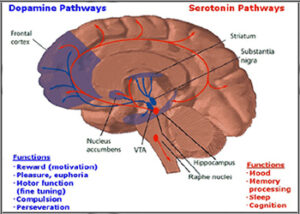 Pleasure is a short sensual experience, and is perceived in eating good food, listening music, enjoying fragrance, seeing nice things and sexual pleasure etc. 3,4 These experiences purely depend on external world and usually one requires money or some form of asset is required as an exchange to fulfill this pleasure. The substrates for pleasures are dopamine (DA) and serotonin (Se) while driving force is catecholamines (NA). These all are brain chemicals: neurotransmitters.5-7
Pleasure is a short sensual experience, and is perceived in eating good food, listening music, enjoying fragrance, seeing nice things and sexual pleasure etc. 3,4 These experiences purely depend on external world and usually one requires money or some form of asset is required as an exchange to fulfill this pleasure. The substrates for pleasures are dopamine (DA) and serotonin (Se) while driving force is catecholamines (NA). These all are brain chemicals: neurotransmitters.5-7
Joy the next level (mental level) is a mixed level, as it brings happiness from both; the inner and the outer world; it is longer lasting and psychological. Service to humanity, success, money, awards, achievements, creativity and simple religious practices lead to joy.9 Vasopressin, prolactin and oxytocin are substrates of joyful activities in addition to DA, Se, & NA. These Neuropeptides / chemicals bring social recognition and bonding, leading to joy.11-12 Performing music is a matter of joy, while listening to music is an activity of pleasure.
Neural Circuitry of Joy
Figure 2: Illustration of Oxytocin and Vasopressin pathways of the brain.
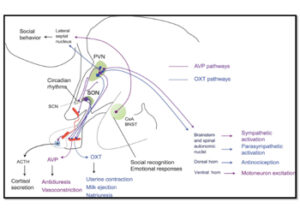 Bliss (spiritual level) is the highest state, where activities of mind ceases and apparently consciousness becomes identified with the universal consciousness, and it is achieved by mindfulness practice, yogic practices and meditation. It is a state of just being.13 Main substrates / neuropeptides here are endorphins, GABA and endocannabinoids & no more dopamine, serotonin. In Indian spiritual context, these three levels are tamasik (pleasure), Rajasik (Joy) and Satvik (Bliss) … Body, mind & spirit.14
Bliss (spiritual level) is the highest state, where activities of mind ceases and apparently consciousness becomes identified with the universal consciousness, and it is achieved by mindfulness practice, yogic practices and meditation. It is a state of just being.13 Main substrates / neuropeptides here are endorphins, GABA and endocannabinoids & no more dopamine, serotonin. In Indian spiritual context, these three levels are tamasik (pleasure), Rajasik (Joy) and Satvik (Bliss) … Body, mind & spirit.14
Neutral Circuitry of Bliss
Can we measure Happiness ? Yes, Happiness can be measured with neuropsychological testing, advanced EEG techniques (MEG), fMRI, SPECT and PET scan. Different components of happiness are found in different areas of brain e.g., laughter responses are generated in pre-frontal cortex. Good events activate rostral anterior cingulated gyrus, ventral tagmental area and amygdale etc.15
Figure 3: Illustration of Bliss pathways of the brain.
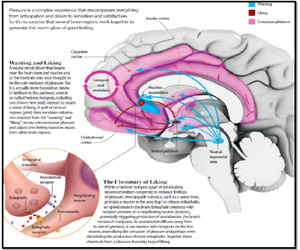 Happiness of a person is determined half of the times by following things: his/her genes (20%), circumstances of life (10%); monetary status (affluence) and health (20%). Rest half of the happiness really comes from morality, attitude, relationship management & spirituality of a person.
Happiness of a person is determined half of the times by following things: his/her genes (20%), circumstances of life (10%); monetary status (affluence) and health (20%). Rest half of the happiness really comes from morality, attitude, relationship management & spirituality of a person.
Some people are born happy, a gene effect. Oscar Wilde said correctly, “Some cause happiness, wherever they go, others whenever they go”. To some extent, certain genes decide our happy outlook towards life: Some of these genes are VMAT2, HTTLPR, FAAH, MAOA, DRD2, DRD4, HTRIA etc. While we await gene editing as a therapy to achieve happiness, we can at least modify gene expression based on the principles of Epigenetics. By altering our thoughts and behaviors and by our altruistic actions as well as meditation; we can change our gene expressions and can unlock the DNA code. Next thing to realize is that circumstances do pass away. They cause temporary effects on over all happiness level of a person in life. Money is important and needed for security, for education & standard of living. However more money & more success cannot bring more happiness. In fact, excess of money takes away morality, spoils relations and may corrupt health. 16-19
When wealth is lost nothing is lost, but when health is lost something is lost and when character is lost everything is lost.
Determinants of Happiness
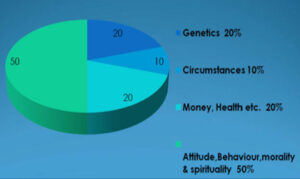
HOW TO BE HAPPIER ? KEYS TO ENJOY A HAPPY LIFE
Physical Health is vital. III health cannot allow us to remain in happy state. So eat right, do exercise, get enough sleep, and learn to relax. Also laugh exhaustingly and love abundantly.20-21 Proper exercise is important. Walking, running, gym, swimming & aerobics are examples of good exercises. Resistance training, weight lifting and massage are good for muscles. Yoga and pranayama are excellent for physical health, mental strength & bliss.22 We must thank people including our PM Shri Narendrabhai Modi for promoting Yoga at a global level.23 Certain types of food increase happiness level. In general consuming balanced diet with enough green leafy vegetables, fruits, dry fruits, enough liquids, herbs, olive oil are useful. Mediterranean or similar diet are considered good. Some type of food items are linked with certain neurotransmitters of brain e.g. dopamine level can be increased by consuming apple, watermelon, kauncha seeds. Similarly, serotonin levels can be increased by consuming banana or by doing light stretching exercise or listening to soft music. Oxytocin levels can be raised by chocolate and endorphins by eating pasta, grapes & chili pepper. 24,25 Medical measures for relieving unhappiness are psychological counseling, mood elevators and Psychiatry drugs for treatment of anxiety or depression. In future gene editing therapy might be available. Experimentally, DBS (Deep Brain Stimulation) around peri aqueductal area can produce a feeling of bliss, by relieving pain. 26-28
Relationships play very important role in our life in maintaining our joy. If we manage our relations successfully, life becomes very easy or else it can disturb our peace of life for sure. So, we have to maintain and nurture five (5) great relationships : Relations with our spouse, children, parents & in laws, friends and all people at our work place. We need to love our spouse, be honest and develop deep harmony and understanding. Women want freedom & respect. They need to be validated and cared for. We need to spend quality time with children and friends. Children should be provided good education, culture and high morals of living. It is important that we take care of our parents and parent in laws with due respect. Similarly, we need to respect seniors. Friends are our lifelines. A single or two true friends are enough. They share our feelings without any expectations. Isn’t that amazing that without any blood relation, true friends can go to any limit to help a friend come out from struggles, failures and miseries. What we have to understand that virtual friendships with many on social media is of no use. We need actual physical friends. We should restrict use of social media and rather spend time with actual friends. Social media has done wrong to us on many accounts and has deprived us of our joy, emotions, focus and empathy. Next we should appreciate our colleagues, encourage subordinates and care for our own people, help them and forgive them if they make mistake or hut us.29
Etiquettes are very important. Simple gestures and manners help a lot in earning Happiness. Keep smiling. Smile solves so many problems. Keep Greeting people with Good wishes. Express your feelings and express from heart. “Thank you”. “I care for you”. “Take care”. “I am sorry if I have hurt you”.
Laugh exhaustingly from the core of heart in a true way. Laugh at your own mistakes. Look into the eyes of a persons and call him/her respectfully with his/her name. Be a good listener. Talk less, listen more. Take interest in matters of people whom you converse and appreciate some good virtues. These will make them happy and in turn they will make you happier. Silence is a great tool and prevents so many problems. So observe silence strategically.
Hobbies make our live joyful. Creativity makes life meaningful for each one of us. Reading, writing, music (performing), drawing, painting, dancing, gardening, grooming and so on. Creativity allows oneself to express from within. Great books are the best friends. Music is the medicine for the soul !! So learn music. Pets fill our lives with joy. All these things give meaning to our lives.
All these measures are good but have their own limitations and depend on external world to some extent, while philosophical thinking coupled with great virtues & spiritual practices bring ultimate Happiness. Let us first review the universal laws of life and then embark on journey of Ultimate Happiness.
Time Management is very important quality of happy people.” If you respect time, time will respect You”. Plan your day, month and year very effectively. But do not keep stressful schedules. Do the things that you enjoy. Do all those things which you only have to do. Delegate all other work to people and you may pay them off. Time saved is money earned and more importantly life years earned. Do creative activities and spend time with friends and family or do meditation in this earned time.
5 Universal Laws of Philosophy of Life …
- Law of Attraction-Whatever we intensely desire from the core of our heart eventually materializes in reality. In simple words, it is the ability to attract into our lives, whatever we focus and desire intensely. All thoughts and desires eventually take physical forms. So ask for happiness for yourself, believe that you can surely be happy, document that wish on a paper and then start living as if you are already happy. Then see the miracle of the universe.
- Law of Karma – As you sow, so you reap. So, give to the world the best you have and the best will return back to you.
- Law of Destiny – Nobody gets anything more or before time as far as destiny is concerned.
- Law of Impermanence – “Nothing is permanent”. Everything has its own life. This moment shall pass too, whether good or bad.
- Law of connectedness – “Everything is connected to everything and everything affects everything.” So think from a broader perspective.
Ultimate Happiness
Happiness is the nature of our own existence. To put it in other words, happiness is all the way inside us. Our own inner being is full of Bliss. That is the reason why we love our ownself Real and permanent happiness is not outside. If we explore our own selves and identify the causes of our miseries and subsequently get rid of the same, we all can rediscover our own bliss. The root cause of miseries are nothing but the activities of our own mind that includes our thoughts, desires, emotions, Kashaya (greed, ego, deceit), attachment: raga and dwesha (with moha in the background). If we introspect and purify these processes one by one, then we can surely attain happiness. In other words, unless we control the movement of our mind, and eliminate faulty business of our mind; we cannot be happy truly.
There are certain secret rules of permanent happiness (bliss), we may call them quantum rules of spirituality. These are the rules for obtaining inner and priceless things; happiness, bliss, peace, love, respect. (or other way round).
Firstly, in the inner world, there is no exchange really. Whatever you give to the world, same thing always returns back to you. In other words, whatever we want for ourselves, we have to give to others. If we want love, we have to give love. If we want respect, we have to give respect. So if we want happiness, we have to give Happiness.. as simple as that !! If we give hatred or anger; then we can only get hatred or anger in return.
Secondly, we may get the same thing in multiple proportions, that means not necessarily same quanta. If we give few quanta of love, we may get infinite quanta of love (and only love). Same is true for all such “inner things.”
Third rule is that this thing may come not necessarily from the same person, but may be from absolutely different corner / person. This is where we always get confused and get hurt or baffled. If we reflect and introspect on these rules very deeply, we will realize where we have gone wrong and why so many times our expectations from persons do not hold true.
So in summary; Whatever you give always returns back to you. Moreover, it may come back in infinite quanta (proportion) and from any (different) direction.
Therefore, cultivating 5 inner virtues, following 5 morals, controlling 5 mental processes and doing 5 spiritual practices daily can immensely help in achieving permanent happiness at the level of Bliss.
Cultivating 5 virtues can fill our lives with happiness & abundance. These are gratitude, appreciation, forgiveness, acceptance and kindness (compassion). Appreciate people for their smallest favors. Gratitude and appreciation can change our lives miraculously. These simple things can fill our lives with abundance and grace. We should always use soft & kind words. We must always speak truth.31
Forgiveness is the antidote to anger. Forgive people if they hurt you. It is more important to be kind than being right. Forgiveness is the important key to happiness. First to forgive is the bravest. Similarly ask for forgiveness if you have hurt someone. Be kind & help people. 32,33 Help them in whatever way you can. Kindness, honesty and respect for others are very important core qualities of a human being.. We should not criticize people. There is not enough time to love people as life is too short. So how can one find time to criticize people ? Also we should not compare ourselves with others. Share love & share things that we possess. These should be supplemented with wisdom and courage.30 Accept that you cannot change so many things. Accept willingly. Acceptance is a great virtue.34 These along with humanity, justice & altruism can create plentiful joy.35
5 mental process control our inner peace and happiness. These are attachment, thoughts desires, ego and attitude. To remain in bliss, we have to cut down our attachment and control and purify quality of thoughts. With our thoughts, we create our own universe and our future. Each single thought affects each and every cell of our body. We should guard our thoughts improve them for better.36 Next, we need to reduce our desires. Desire is the root cause of our unhappiness as is attachment. We have to check our emotions and turn them for positive. Above all, our attitude should be positive. Life is 10% what happens to us and 90% how we react to it. It is all in our attitude, how we react to any situations.37We have to be polite and have to let go our ego. Ego is our biggest enemy. So is anger. Anger can destroy relations and families. All these elements contribute to our own temperament : Nature. Therefore, we have to control these mental processes by all possible means.38
There is yet another thing at mental level that is profound and can affect our happiness and outcome and that is our Belief System. What we believe firmly and reaffirm with conviction can actually physically materialize. So believe in your own self, believe that you will be happier day after the day and actually, you will become.
Religion opens the door of happiness & peace. So let us follow religion, maintain ethics & forgive others.
Every true Religion teaches us 5 Morals (Yama) : Morals of Truth, non violence, non stealing, non collectiveness and faithfulness with spouse (or celibacy). We must always speak truth. 31 we should always use soft & kind words while speaking truth. We have to be very honest. We must not kill or hurt any living being, nor we should hurt anyone by our words or even in our thoughts. This is the real Nonviolence. Compassion and love are the other names of Nonviolence. If you have the truth or compassion fully manifested in yourself, then automatically you are the happiest person. You are done with all that is best in a life. If you are nonviolent or truthful, you cannot steal anything from anyone Non stealing), nor you can cheat anybody. Then you shall remain always faithful and honest to your spouse. That is Brahmacharya for all common people. Complete Celibacy is for those who have enunciated the world. Same way, you will not keep on accumulating or collecting worldly things beyond your actual requirements. These five morals constitute core of Indian spiritual way of preaching about how to live our life? We have to adhere to these basic qualities to maintain social and ecological balance apart from religious structure. They therefore contribute towards universal and individual happiness. Righteous knowledge, righteous faith and righteous character are the three important higher keys of blissful happiness. 39-41 Practices of Raja Yoga, Gyan (knowledge) Yoga, Bhakti (Devotion) Yoga and Karma (sincere work without any expectation) Yoga are gateways to spiritual realm.
Spiritual path is the final path. So, those who want the permanent bliss, should regularly do 5 spiritual practices i.e. 1) Do spiritual reading (swadhyaya), 2) attend spiritual discourses (satsang), 3) Offer prayers for universal welfare and peace and do chanting with devotion. 4) Do some or other form of penance or austerities eg. Fasting, service of those who are ailing and suffering. 5) Final step is to do Meditation daily with consistency. There are various types of meditation techniques. Some of them are Mindfulness meditation, Anapan sati, Vipassana, Patanjala rajyoga, Transcendtal meditation, Samayik, Pratikraman, Kayotsarga etc. These and such type of meditation techniques help us to achieve highest state of happiness i.e. Bliss. 42-44 Meditation is the master key. It allows us to purify and control our thoughts, emotions & desires. It allows us to sublime our ego & attachment. Meditation controls all faulty processes of mind. In addition, it sharpens our brain and improves our cognition & judgment for better. Therefore, we must mediate daily.45
Symbolic representation of the SELF
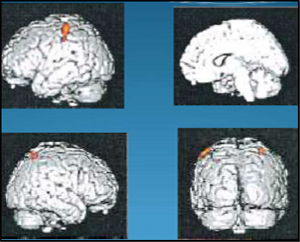
During depth of meditation, blood flow to prefrontal area increases reflecting improvement in cognitive processes while blood flow to parietal area is reduced significantly suggesting improved mental processes, (control of ego, thoughts and desires and improvement in attitude).
SPECT images at Baseline & during Meditation on self
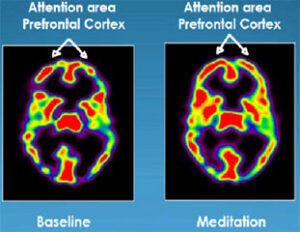

Four noble truths of life of Lord Budhdha :“That we world is full of sufferings. That there is a cause of every suffering. That cessation of suffering is possible if we follow the right path, all sufferings and miseries can be alleviated”.
Formula of Happiness:
| Stop comparing | Stop expecting | Stop criticizing |
| Start sharing | Start helping | Start loving |
| Give & forgive | Enjoy Hobbies e.g. travelling | Enjoy every moment |
| Learn music, dance, art | Read great books | Be with nature |
| Nuture relationships | Appreciate people | Thank heart fully |
| Learn creativity | Count blessings | Follow morals |
| Do sport activities | Do yoga daily | Do exercise |
| Do prayers | Do chanting | Meditate daily |
In summary, we should remember that it is not easy to find happiness in ourselves, but it is not possible to find it elsewhere. There is no way to happiness; happiness is the way. The road to success is different from highway to peace, bliss and longevity. As Lord Mahavir used to say often to his main disciple Gautam : Remain alert and aware every fraction of a moment. Watch and guard your every thought, every word that you speak and every action that you do. Thus, if you really want to be happy, then just be yourself and enjoy inner experiences.
REFERENCES :
- Lama D, Cutler HC, eds. The Art of Happiness : A handbook of living. Hodder and Stoughton. 1988;1 (1).
- Thin N. effects of happiness (and unhappiness) Eds. Social happiness: Theory into policy and practice. Policy Press; 2012: 3:49.
- Kringelbach ML, Berridge KC. The neuroscience of happiness and pleasure. Social research, 2010; 77(2) : 659.
- Bloom P. How pleasure works : The new science of why we like what we like 2010 New York. NY WW Norton.
- Berridge KC, Kringelbach ML. Pleasure systems in the brain. Neuron, 2015 May 6; 86(3) : 646-64.
- Laddha GP, Vidyasagar G. Bavaskar SR, Baile SB, Suralkar SS. Serotonin : A dive of pleasure and misery. Structure. 2012; 1:2.
- Baixauli Gallego E. Happiness: role of dopamine and serotonin on mood and negative emotions. Emergency Medicine (Los Angeles). 2017; 6(2): 33-51.
- DolleCommunications Blog. Neurochemicals of the brain. Available athttps://dollecommunicationsblog.wordpress.com/tag/neurochemicals-of-the-brain/Accessed on 25th November, 2019.
- Cottrell L. Joy and happiness : a simultaneous and evolutionary concept analysis. Journal of advanced nursing. 2016; 72(7) : 1506-17.
- Black JS. Oxytocin : the “Love Hormone”. 1990. Conference: 6th Advanced Course, RANZCOG At : Adelaide, Australia.
- CW Headley. How oxytocin can help us be more neurologically productive. Ladders. Available athttps://www.theladders.com/career-advice/on-oxytocin-and-neurological productivity Accessed on 26th November, 2019.
- Moschella MC Z; eds. Caring for Joy: Narrative, Theology, and Practice. BRILL. 2016; 1:40-41.
- Johnson BJ. Bliss. Periodic Table of Spiritual Elements. Create Space Independent Publishing Platform. 2016.
- Mohandas E. Neurobiology of Spirituality. Mens Sana Monogr. 2008;6(1):63-80.
- Berridge KC, KringelbachML.Building a neuroscience of pleasure and well-being.
- Bergink J. Happiness : It’s not just your genes, stupid! For a state of Happiness. 2015. Available athttp://www.forastateofhappiness.com/tag/50-10-40-formula/Accessed on 26th November 2019.
- Carr A. Happiness, eds. Positive Psychology: The Science of Happiness and Human Strengths. 2nd edition. Routledge: Taylor & Francis Group. 2011:1-47.
- Blum K. ChenAL, Chen TJ, BowirratA, Downs BW, Waite RL, et al. Genes and happiness. Gene Therapy and Molecular Biology. 2009 Jun: 13:91-129.
- McWilliam R.A. cause for happiness.. Journal of Early Intervention. 2002;25(2):75-77.
- Ventegodt S, Merrick J. Health and happiness from meaningful work: Research in quality of working life. Nova Science Publishers; 2009.
- Miquelon P. Vallerand RJ. Goal motives, well-being, and physical health: Happiness and self-realization as psychological resources under challenge. Motivation and Emotion. 2006 Dec 1:30(4):259-72.
- Siddiqui Nl, NessaA, Hossain MA. Regular physical exercise: way to healthy life. Mymensingh medical journal: MMJ. 2010 Jan;19(1)154-8.
- The Economic Times. PM Narendra Modi’s efforts got Yoga internationally recognized: AYUSH Minister Shripad Yesso Naik. Sep 29, 2015. Available athttps://economictimes.indiatimes.com/news/politics-and-nation/pm-narendra-modis-efforts-got-yoga-internationally-recognised-ayush-minister-sripad-yesso-naik/articles show/49156766. cms?from=mdr Accessed on 26th November 2019.
- Hanly L. Foods that trigger the relase of dopamine. Available athttps://www.livestrong.com/article/64566-foods-trigger-release-dopamine/Accessed on 26th November 2019.
- Foods that increase serotonin, dopamine and endorphins. Available athttps://www.cheap-health-revolution.com/foods-that-increase-serotonin.html Accessed on 26th November, 2019.
- Kocsis JH. Happy pills in America J Cin Invest 2009 Jul 1: 119(7): 1744.
- Veenhoven R. effects of happiness on physical health and the consequences for preventive health care. Journal of Happiness Studies 2008;9:449-469.
- Schermer M. Health, happiness and human enhancement-dealing with unexpected effects of deep brain stimulation. Neuroethics. 2013 Dec 1:6(3):435-45.
- Edwards J. Goldie I, Elliott I, Breedvelt J, Chakkalackal L, Foye U. Relationships in the 21st Century: The forgotten foundation of mental health and wellbeing. Mental Health Foundation. 2016:1-28.
- Clark K. Samuel A. Morality and happiness. Evidence and Religious Belief. 2011 Jul 28:157-74.
- WellSpring International Educational Foundation. Divine Virtues & Spiritual Qualities. Available at https://virtuesproject.com/Pdf/DivineVirtuesSpiritualQualities.pdf Accessed on 26th November 2019.
- McCullough ME, Witvliet CV. The psychology of forgiveness. Handbook of positive psychology. 2002;2:246-55.
- Maltby J, Day L, Barber L. Forgiveness and happiness. The differing contexts of forgiveness using the distinction between hedonic and eudaimonic happiness. Journal of Happiness Studies. 2005 Mar 1:6(1):1-3.
- Szentagotai A, David D. Self-acceptance and happiness. In The strength of self-acceptance 2013 (pp. 121-137). Springer, New York NY.
- Franklin SS. They psychology of happiness: A good human life. Cambridge University Press: 2010.
- Stevens TG. You can choose to be happy: “rise above” anxiety, anger and depression. Wheeler Sutton Publishing Company, 1998.
- Mathis J. Reinventing Your Problem: Change Your Attitude, Change Your Results. Available at https://michmab.com/editorial-reinventing-your -problem/?print=print Accessed on 26th November 2019.
- Rajvanshi AK. Neurobiological Basis of Ego and Anger. Nimbkar Agricultural Research Institute. 2012. Available at https://nariphaltan.org/ego.pdf Accessed on 26th November 2019.
- Sander W. Religion, religiosity, and happiness. Review of Religious Research. 2017 Jun 1:59(2):251-62.
- Francis LJ, Yablon YB, Robbins M. Religion and happiness: A study among female undergraduate students in Israel. International Journal of Jewish Education Research.2014;7:77-92.
- Fidrmuc J, Tunali CB. Happiness and religion. CESifo Working Paper No.5437. Centre for economic studies and Info Institute. Available at http://iset-pi.ge/images/Lectures_Seminars/Happiness_and_Religion_Paper.pdf Accessed on 26th November 2019.
- Kunugi Rt. The Path to True Happiness. 1988.
- Bhandari N. Jainism: The Eternal and Universal path for Enlightenment. 2009.
- Das I, Anand H. Effect of Prayer and “OM” Meditation in enhancing galvanic skin response. Psychological Thought. 2012; 5(2): 141-149.
- Thanissaro PN. The Spiritual Benefits of Meditation. In book: Healing Power of Meditation: Wisdom and Encouragement from The Meditation Center of Alabama. 2018:43-55.
Courtesy to GSB IMA: Reprint of article – 31st August, 2020 issue of Gujarat Medical Journal. (Editor: Dr. K.R. Sanghvi) page 58 to 64.


Very Nice
naturally like your web site however you need to take a look at the spelling on several of your posts. A number of them are rife with spelling problems and I find it very bothersome to tell the truth on the other hand I will surely come again again.
Wow, this blogger is seriously impressive!
Your article helped me a lot, is there any more related content? Thanks!